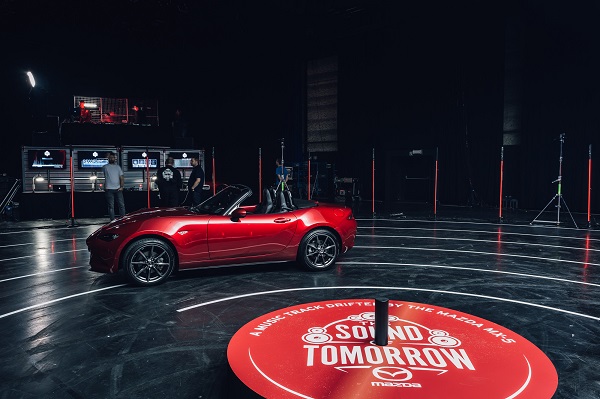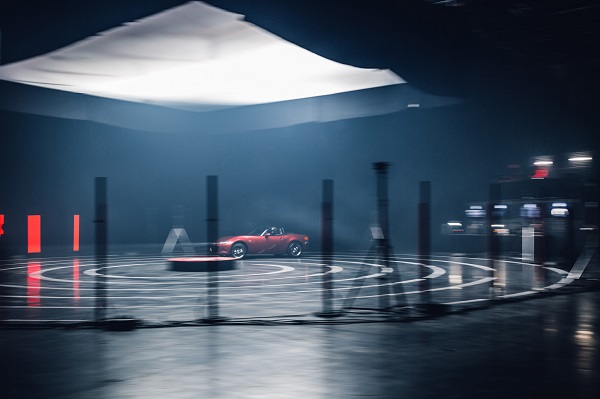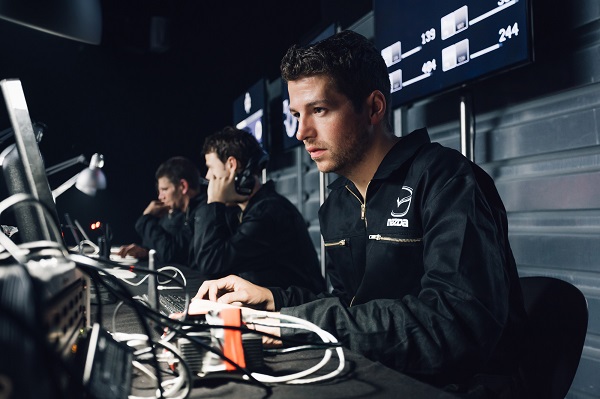To promote the sports model MX-5, Mazda created “Mazda Drives: The Sound of Tomorrow” campaign, the highlight of which is a special DJ concert by DJ Vicious, six-time Tomorrowland DJ, with flair as the Mazda MX-5 made music on a large vinyl record in place of a pick up needle.
The Sound of Tomorrow is being beautifully advertised through the image of a car making music both in the literal and the figurative sense. The set is a huge vinyl record and the Mazda MX-5 will create music by driving on it. The car’s precise and sharp steering enables it to act as a replacement pick up needle.
 |
|
To promote the MX-5 Mazda sports vehicle, the company has launched a sepcial DJ concert that uses cars as the pick up needle of a large vinyl record. IR LEDs on surrounding cameras also helped create special visual effects. (All photos courtesy of Mazda) |
The idea was brought forward by advertising agency, These Days, and the production company, MoJuice, took care of the tech setup, the production of the clip and the recommended use of BlackTrax realtime motion tracking system.
The tracking was the missing component between all the parts. BlackTrax was the right solution as not only its tracking is realtime but also BlackTrax outputs the open source RTTrP protocol for anyone to read or write to, and receive the positional data making custom solutions possible.
Joachim Sas, marketing director at Mazda Belux, said: “The object of this campaign is to establish the link between Mazda and music in general and Tomorrowland in particular.”
 |
|
IR LEDs can be seen on surrounding poles around the MX-5 Mazda vehicle. |
To be able to pull this off the Mazda MX-5 was equipped with BlackTrax Beacons using IR LEDs and eight BlackTrax cameras. In real-time, these picked up the signals of movement of the car at its precise position on a reconstructed model of a ‘vinyl’. The spiral on the vinyl is actually the coded music. The information was then delivered to the sound equipment that was based on instructions from the car’s movement, played the track.
Maarten Francq, 3D Motion Technologist, said: “Everything that happens on the large scale vinyl is replicated on the decks and the music is played. If the car goes too fast then the music will also play too fast, if the car is too slow then the track will play too slowly. If the car leaves the trajectory on the spiral there will be an effect similar to scratching a vinyl record and the music will jump to the next track.”
There was a great amount of technology brought for this endeavor but the most essential thing to the success of this project was a good partnership between the DJ and the driver. The DJ must be able to give the driver pointers to drive faster, slower or change direction.
 |
|
The car and cameras rolling into action. |
DJ Licious, six-time Tomorrowland DJ, said: “The concept of having to drive a car like a pick up needle was absolutely amazing. Synchronising the car’s laser with the sound equipment and giving precise instructions to a highly talented driver is something I don’t get to do everyday.”
The MX-5 is the ideal car for this experiment because it is compact, it has the right engine and the required distinguished characteristics on top of its fantastic steering.
The driver of the Mazda MX-5 was Jan Wouters, a professional Belgian race driver. He said: “While it is possible to maintain a specific racing line, I wouldn’t exactly call it easy. Still, the MX-5 is highly qualified for the job because the engine is located at the front. Since the engine is not located in the middle or at the back the pendulum effect is less pronounced and this makes the car much more maneuverable with the accelerator pedal.”
Mazda’s MX-5 makes beautiful music for its Sound of Tomorrow campaign.
Find out more about the campaign at: http://soundoftomorrow.be/en
 |
|
Mazda staff checking the performance of the vehicle and sound effects. |















